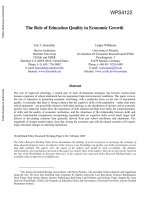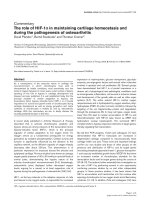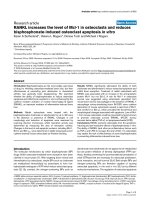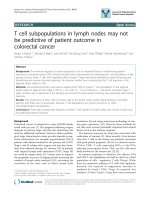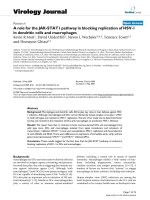Role of stathmin 1 in colorectal cancer metastasis and chemo resistance
Bạn đang xem bản rút gọn của tài liệu. Xem và tải ngay bản đầy đủ của tài liệu tại đây (8.31 MB, 175 trang )
ROLE OF STATHMIN-1 IN COLORECTAL CANCER
METASTASIS AND CHEMO-RESISTANCE
WU WEI
B. Sc (Hons), NUS
A THESIS SUBMITTED
FOR THE DEGREE OF DOCTOR OF PHILOSOPHY
DEPARTMENT OF BIOCHEMISTRY
NATIONAL UNIVERSITY OF SINGAPORE
2014
i
DECLARATION
I hereby declare that this thesis is my original
work and it has been written by me in its entirety.
I have duly acknowledged all the sources of
information which have been used in the thesis.
This thesis has also not been submitted for any
degree in any university previously.
_________________________
Wu Wei
23
rd
January 2014
ii
Acknowledgement
“All that is valuable in human society depends upon the
opportunity for development accorded the individual.”
Albert Einstein.
It was my utmost privilege to receive the mentorship of three great scientists. As I
reflect in the final lap upon this journey, these opportunities appear even more
valuable than ever.
I am immensely grateful for the opportunity to work under A/P Maxey Chung Ching
Ming, who saw faith in an enthusiastic but otherwise mediocre student. Without his
encouragement and dedicated care, this amazing four-year adventure would never
have been any more than the desire to explore. I also thank Dr. David Balasundaram
for captivating me with his passion for science almost a decade ago. Till this day, I
remember the shine in his eyes at that eureka moment we shared. I am also
indebted to A/P Alan G Porter who provided the best environment to learn
experimental techniques, and for trusting that a third-year undergraduate just picking
up cancer biology was worth his time.
I am also blessed to have supportive thesis advisors who were genuinely concerned,
as well as efficient department staff whom I trouble frequently, but still remain
friendly. This voyage was never lonely, for I had labmates who shared the joy of
making discoveries and never failed to spur me on. Thank you all.
This thesis is dedicated to my parents, who held the conviction that I was meant to
pursue this path, and bestowed upon me the fortitude to take on this challenge. With
your love, I made it.
iii
Table of Contents
Acknowledgement ii
List of figures vii
List of Tables x
Summary xii
Abbreviations xiii
Chapter 1 Introduction 1
1.1 Colon cancer 2
1.1.1 Colorectal carcinoma 2
1.1.2 Diagnosis and staging 4
1.1.3 CRC survival 6
1.1.4 CRC treatment 8
1.2 Stathmin-1 9
1.2.1 The Stathmin family 9
1.2.2 STMN1 in microtubule regulation 10
1.2.3 STMN1 in cell cycle regulation 12
1.2.4 STMN1 in cancer 14
Chapter 2 Objective of study 15
2.1 Motivation of study 16
2.1.1 STMN1 up-regulation in metastatic CRC 16
2.1.2 Knowledge gaps and experimental aims 20
2.2 Workflow 22
Chapter 3 Results 25
3.1 Stable STMN1 knockdown and over-expression 26
3.1.1 STMN1 knockdown 28
3.1.2 STMN1 over-expression 30
3.1.3 Summary 31
3.2 STMN1 expression is required for metastatic processes in vitro 33
iv
3.2.1 Migration 34
3.2.2 Invasion 36
3.2.3 Adhesion 37
3.2.4 Colony formation 38
3.2.5 Growth 39
3.2.6 Summary 40
3.3 STMN1 silencing regulates the metastatic proteome 41
3.3.1 iTRAQ
TM
Summary statistics 42
3.3.2 Metastatic balance 44
3.3.3 Cell junctions and intracellular architecture 46
3.3.4 Apoptotic defense 48
3.3.5 Validation 50
3.3.6 Summary 54
3.4 STMN1 silencing enhances cellular anchorage and intracellular rigidity 55
3.4.1 Hemidesmosomes 56
3.4.2 Desmosomes and intermediate filaments 57
3.4.3 Summary 58
3.5 STMN1 silencing promotes 5-Fluorouracil sensitivity 59
3.5.1 General cytotoxicity 60
3.5.2 5-Fluorouracil sensitisation 62
3.5.3 Caspase-dependent apoptosis 64
3.5.4 Caspase 6 activity 66
3.5.5 Summary 68
3.6 STMN1 silencing regulates transcript abundance 69
3.6.1 p38 phosphorylation 70
3.6.2 Quality control 72
3.6.3 CRC progression and cytoskeletal remodelling 74
3.6.4 Metastatic and EMT transcriptional profile 76
3.6.5 Validation 79
3.6.6 Summary 80
3.7 Regulation of STMN1 function 81
3.7.1 STMN1 interactions 82
3.7.2 Fibronectin stimulation 86
3.7.3 p53 dependence 87
3.7.4 STMN1 phosphorylation 90
3.7.5 S25/38 phosphorylation in metastatic processes 92
v
3.7.6 Summary 94
Chapter 4 Discussion 95
4.1 Experimental strategy 96
4.2 STMN1 expression drives in vitro metastatic phenotype 97
4.3 Molecular benefits of STMN1 silencing 99
4.4 STMN1 interactions and S25/38 phosphorylation determine pro-metastatic
activity 101
4.5 STMN1 silencing regulates metastatic networks 103
4.6 STMN1 silencing: a potential therapy against metastatic CRC 104
Chapter 5 Conclusion and future work 107
Chapter 6 Materials and methods 110
6.1 Cell lines and constructs 112
6.1.1 HCT116 and E1 cell lines 112
6.1.2 Preparation of whole cell lysate 112
6.1.3 STMN1 KD and OE constructs 113
6.1.4 Mutagenesis 113
6.1.5 Transfection 114
6.2 Cell-based assays 115
6.2.1 Proliferation 115
6.2.2 Wound healing 115
6.2.3 Transwell migration 116
6.2.4 Matrigel invasion 117
6.2.5 Cell adhesion 117
6.2.6 Anchorage-independent colony formation 118
6.3 Proteome profiling 119
6.3.1 iTRAQ
TM
: labeling chemistry 119
6.3.2 iTRAQ
TM
: sample preparation 120
6.3.3 iTRAQ
TM
: 2D LC-MS/MS 121
6.3.4 iTRAQ
TM
: protein and peptide identification 122
6.3.5 iTRAQ
TM
: data analysis 123
6.3.6 SWATH
TM
MS: label-free technology 124
6.3.7 SWATH
TM
MS: sample preparation and analysis 125
6.3.8 SWATH
TM
MS: protein identification and quantitation 126
vi
6.4 Transcript analysis 127
6.4.1 RNA extraction and quantification 127
6.4.2 qPCR array 127
6.5 Molecular methods 128
6.5.1 1D western blotting 128
6.5.2 2D western blotting 129
6.5.3 Dephosphorylation 130
6.5.4 Immuno-fluorescence 131
6.5.5 Cytotoxicity 132
6.5.6 Flow cytometry 132
6.5.7 Caspase inhibition 133
6.5.8 Caspase 6 activity 133
6.6 Data representation 135
6.6.1 Graphs and data visualisation 135
6.6.2 Images 135
6.6.3 Statistical analyses 135
Appendix I: Proteins regulated by STMN1 silencing (iTRAQ
TM
) 136
Appendix II: Regulated proteins validated by SWATH
TM
142
Appendix III: Transcripts regulated by STMN1 silencing (qPCR) 143
Publications 144
Conference presentations 145
Awards 146
Bibliography 148
vii
List of Figures
Chapter 1 Introduction
Figure 1-1: Survival of primary and metastatic CRC 6
Figure 1-2: Stathmin family multiple sequence alignment 9
Figure 1-3: STMN1 regulates MT and mitotic spindle dynamics during cell cycle 12
Chapter 2 Objective of study
Figure 2-1: STMN1 is significantly up-regulated in hepato-metastatic cell line E1 17
Figure 2-2: STMN1 expression increases with CRC progression 18
Figure 2-3: STMN1 expression indicates CRC prognosis 19
Figure 2-4: Experimental workflow 23
Chapter 3 Results
Figure 3-1: Representative colony amplified from a single stably-transfected cell 28
Figure 3-2: Morphology of STMN1 KD and SC cells 29
Figure 3-3: Morphology of STMN1 OE and vector control cells 30
Figure 3-4: Panel of stable STMN1 KD and OE cell lines 31
Figure 3-5: STMN1 expression is required for efficient wound healing 34
Figure 3-6: STMN1 expression promotes cell migration 35
Figure 3-7: STMN1 expression promotes matrix invasion 36
Figure 3-8: STMN1 expression inhibits cell adhesion 37
Figure 3-9: STMN1 expression promotes anchorage-independent growth 38
Figure 3-10: STMN1 expression confers no proliferative advantage 39
Figure 3-11: Functional classification of targets regulated by STMN1 silencing 43
Figure 3-12: Hemidesmosomes 46
viii
Figure 3-13: Desmosomes 47
Figure 3-14: iTRAQ
TM
validation by western blotting 50
Figure 3-15: iTRAQ
TM
validation by immuno-fluorescence 51
Figure 3-16: STMN1 silencing strengthens hemidesmosomes 56
Figure 3-17: STMN1 silencing increases intracellular rigidity 57
Figure 3-18: STMN1 silencing promotes sensitivity to MT inhibitors and 5FU 60
Figure 3-19: Microtubule inhibition and 5FU treatment decrease STMN1 level 61
Figure 3-20: STMN1 silencing amplifies 5FU-dependent apoptosis 63
Figure 3-21: 5FU-induced apoptosis is caspase-dependent 64
Figure 3-22: 5FU sensitisation in STMN1 KD cells depends on Caspases 3 and 6. 65
Figure 3-23: Caspase 6 activity amplifies 5FU sensitivity 66
Figure 3-24: Caspase 6 activation and cleavage of Lamin A 67
Figure 3-25: Model of STMN1 silencing induced 5FU sensitisation 68
Figure 3-26: p38 phosphorylation 70
Figure 3-27: qPCR reproducibility 73
Figure 3-28: STMN1 KD inhibits CRC progression and cytoskeletal remodelling 74
Figure 3-29: STMN1 KD reverses metastatic and EMT transcriptional profile 77
Figure 3-30: qPCR validation by western blotting 79
Figure 3-31: STMN1 is enriched by immuno-precipitation 82
Figure 3-32: 2D separation of STMN1 IP eluate 83
Figure 3-33: STMN1 potentially interacts with RhoGAP8 84
Figure 3-34: STMN1 may regulate G protein signaling
85
Figure 3-35: Fibronectin induces STMN1 expression 86
Figure 3-36: STMN1 silencing perturbs p53 transcirptional network 87
Figure 3-37: Stable STMN1 silencing in HCT116 p53
-/-
cells 88
Figure 3-38: Functional p53 not required to achieve efficacy of STMN1 silencing 88
Figure 3-39: STMN1 is phosphorylated at S16, 25, 38 and 63 in CRC cells 90
Figure 3-40: Rescue of STMN1 KD by phosphorylation defective mutants 92
ix
Figure 3-41: STMN1 pro-metastatic activity depends on S25/38 phosphorylation 93
Chapter 4 Discussion
Figure 4-1: Structure of STMN1 protein (schematic) 101
Figure 4-2: Model of STMN1 inhibition in CRC 105
Chapter 6 Materials and methods
Figure 6-1: Wound healing insert 115
Figure 6-2: Transwell migration insert. 116
Figure 6-3: Matrigel invasion chamber. 117
Figure 6-4: iTRAQ labels 119
Figure 6-5: iTRAQ reporter ions 120
Figure 6-6: iTRAQ sample pooling 120
Figure 6-7: iTRAQ experimental workflow. 121
Figure 6-8: iTRAQ threshold filtering. 123
Figure 6-9: SWATH acquisition 124
x
List of Tables
Chapter 1 Introduction
Table 1-1: STMN1 up-regulation in cancer and disease 14
Chapter 3 Results
Table 3-1: iTRAQ
TM
summary statistics 42
Table 3-2: STMN1 silencing upsets CRC metastatic balance 44
Table 3-3: STMN1 silencing promotes cellular anchorage and intracellular rigidity . 46
Table 3-4: STMN1 silencing tips the balance in favour of cell death 48
Table 3-5: Verification of iTRAQ
TM
data by SWATH
TM
MS 52
Table 3-6: RNA quality 72
Chapter 6 Materials and methods
Table 6-1: Mutagenesis primers 113
Table 6-2: Primary antibodies for western blotting. 128
Table 6-3: Secondary antibodies for western blotting. 129
Table 6-4: Immuno-fluorescence antibodies 131
xi
BLANK PAGE
xii
Summary
Colorectal carcinoma (CRC) is a perennial concern in public health. While primary
lesions detected early are largely curable by surgical resection and peri-operative
chemotherapy, metastatic spread contributes significantly to CRC-related deaths.
Hence it follows that reducing loss of lives to CRC should involve metastatic
inhibition and improving chemo-response.
Based on a proteome comparison between isogenic primary and metastatic CRC
cell lines, Stathmin-1 (STMN1) was found to be significantly up-regulated and
associated with CRC metastasis. Clinically, high STMN1 expression was also highly
correlated with CRC metastatic progression and strongly indicative of poor disease-
free survival. This work demonstrates that high STMN1 expression is sufficient to
initiate metastatic processes in vitro, through promoting metastatic protein
expression, as well as modulating oncogenic and mesenchymal transcription.
STMN1 silencing on the other hand reinstates the default cellular programme of
metastatic inhibition, and significantly improves chemo-response to 5FU through a
novel caspase 6-dependent mechanism.
Moreover, this work demonstrates that STMN1 function in metastatic processes may
be further regulated at the expression level by chemo-attractant stimulation, at the
interaction level through potential binding to RhoGAP8, and by phosphorylations at
S25 or S38, which have profound consequences on migratory and invasive
processes. These findings establish STMN1 as a potential target in anti-metastatic
therapy, and demonstrate the power of an approach coupling proteomics and
transcript analyses in the global assessment of treatment benefits and potential side-
effects.
xiii
Abbreviations
CRC colorectal carcinoma
EMT epithelial-to-mesenchymal transition
FDR false discovery rate
IF intermediate filament
iTRAQ
TM
isobaric tags for relative and absolute quantitation
IPA ingenuity pathway analysis
KD knockdown
MT microtubule
OE over-expression
pI iso-electric point
SC scrambled control
S.D. standard deviation
S.E. standard error
STMN1 stathmin-1
SWATH
TM
MS sequential window acquisition of all th
TMA tissue microarray
eoretical mass spectra
TBHP tert-butyl hydroperoxide
Vec vector control
2D-DIGE two-dimensional difference gel electrophoresis
5FU 5-Fluorouracil
1
Chapter 1 Introduction
2
1.1 Colon cancer
1.1.1 Colorectal carcinoma
Colorectal carcinoma (CRC) is a perennial concern in public health
1
. According to
yearly estimates from the American Cancer Society for the year 2013, more than 140
thousand people in the United States alone are expected to develop CRC, and the
estimated deaths from CRC and metastatic complications are projected to exceed 50
thousand. CRC is thus likely to make up about 10% of all cancer incidence and
mortality in 2013
2
. Consistent with trends in developed countries, CRC is the most
frequent cancer in Singapore, accounting for 14% to 18% of all cancer incidence
between 2005-2009
3
.
Colorectal cancers usually begin as non-cancerous polyps in the inner lining of the
colon or rectum
4
. Over many years, adenomatous polyps in the dysplasic colon may
develop into pre-neoplastic lesions upon genetic, chemical or environmental trigger.
Since more than 95% of all CRCs are adenocarcinomas, neoplastic polyps
(adenomas) are frequently regarded as the earliest signs of possible CRC
development.
Numerous CRC risk factors have been proposed, and these may be categorised
broadly into hereditary or lifestyle predispositions. Among the heritable factors, family
history of colorectal polyps
5
or inflammatory bowel disease
6
are well-documented
risks for developing CRC, while familial adenomatous polyposis (FAP)
7
and
hereditary non-polyposis colon cancer (HNPCC)
8
are driven by heritable mutations.
Lifestyle also significantly influences the odds of developing CRC. In particular, low
fibre diet rich in red meat
9
and lack of regular exercise
10
appear to correlate closely
with CRC incidence. Since physical inactivity, obesity, smoking and heavy alcohol
3
use are shared lifestyle risks between CRC and type II diabetes (T2D), patients with
T2D also appear to be predisposed to CRC
11
.
Various gene mutations have been reported to drive CRC development
12
. Inherited
APC mutation causes FAP
13
while defective DNA repair machinery (MLH1, MSH2)
causes HNPCC
14
. Sporadic mutations in KRAS
15
and TP53
16
on the other hand are
most well documented to fuel tumour growth in CRC.
4
1.1.2 Diagnosis and staging
Given the asymptomatic nature of early lesions, CRC diagnosis has been a constant
challenge. Up to 60 cm of the rectum and colon may be surveyed by flexible
sigmoidoscopy
17
, while visual inspection of the entire colon is only possible with
colonoscopy
18
, which remains the gold standard in detection of early colonic
abnormalities. Virtual colonoscopic methods like double contrast barium enema
19
and CT colonography
20
could also pick up potential cancerous lesions but the
resolution is generally limited by accessibility of barium sulfate to early lesions and
three-dimensional reconstruction of the inner colon surface. Since these often still
require verification by standard colonoscopy, the utility of virtual colonoscopic
techniques remains somewhat limited unless reducing invasiveness is critical.
Other than imaging methods, analysis of fecal content could also indicate the
presence of colonic abnormalities. Fecal occult blood test (FOBT) and fecal
immunochemical test (FIT) detect the presence of blood in fecal matter
21
, and are
completely non-invasive, but these generally cannot distinguish between cancerous
lesions, or ulcers, haemorrhoid, diverticulosis and colitis due to benign conditions. In
addition, these tests are also only sensitive against tumours that bleed, or advanced
tumours that have invaded extensively into the colon wall. Stool DNA test could also
detect the presence of mutations in abnormal cells that dislodge from growing
tumours in the colon
22
. When any of the diagnostic tests turns up positive, biopsies
may be obtained in follow-up colonoscopy or via laparoscopic techniques
23
for
confirmation and CRC staging.
Accurate CRC staging requires physical examination, analysis of biopsies, as well as
imaging tests like CT, MRI
24
or PET scans. The most commonly used method of
5
CRC staging is the TNM system provided by the American Joint Committee on
Cancer (AJCC). This method measures the extent of CRC progression by scoring
the depth of tumour penetration into colonic wall (T), the extent of regional
metastasis to the lymph nodes (N), and presence of metastatic spread to other
organs (M)
25
. Based on such categorical scoring, the staging is complete when TNM
parameters are combined and assigned a stage with Roman numerals. In general,
localised CRC tumours are either Stage I or II depending on the depth of penetration,
while Stage III involves lymph node metastasis, and Stage IV metastatic spread to
other organs, of which the most common sites are liver or lung.
6
1.1.3 CRC survival
Driven by nationwide campaigns to screen for CRC in individuals above the age of
50, detection of CRC has improved significantly over the years
26
. Nonetheless, the
challenge remains to prevent metastatic spread after surgery, which accounts
significantly for CRC-related mortality worldwide
1
. According to five-year survival
data obtained between 2002-2008 (Figure 1-1), as high as 90% of primary CRCs are
curable by resection, but only 12% of patients with distant metastases survive
beyond 5 years
2
. This highlights the paramount importance of CRC metastatic
prevention.
Figure 1-1: Survival of primary and metastatic CRC. Figure reproduced with modifications from
Cancer statistics 2013
2
.
Preventing CRC metastasis requires a precise molecular understanding of the
metastatic progression. Given the complexity of metastatic signaling and multi-level
regulation of metastatic balance, targeting the CRC metastatic cascade is extremely
difficult, not to mention that a comprehensive assessment of possible side effects is
grossly lacking. In the most ideal metastatic inhibition, targeting a single molecule at
the crossroads of CRC metastatic cascades should reduce metastatic phenotype by
blocking several pathways specific to tumour disseminative function.
7
Alternatively, preventing CRC metastasis may require early diagnosis and accurate
prognosis, allowing the stratification of a patient sub-category at risk of accelerated
tumour progression, or developing metastatic disease. These patients should then
be screened at higher frequency compared to the normal recommendation, to make
the earliest detection of metastasis. More aggressive treatment may also be
justifiable at an early stage for these patients to improve the odds of survival. Yet,
these approaches are not currently possible, since no reliable prognostic biomarkers
are available to date.
8
1.1.4 CRC treatment
CRC treatment may involve combinations of surgical resection, radiation therapy,
chemotherapy or targeted therapy administered sequentially or simultaneously
27
.
CRCs detected as localised tumours in Stages I and II generally require only surgical
resection, while the benefit of adjuvant chemotherapy is controversial
28, 29
. Typically,
open or laparoscopic-assisted colectomy
30
is performed to remove the affected colon
segment and neighbouring lymph nodes, while local excision during endoscopic
examination is also possible to remove smaller lesions.
In addition to surgical resection, peri-operative radiation and chemotherapy are
generally prescribed for CRC patients in advanced stages. Chemical treatment
regimes involving 5-Fluorouracil (5FU) in various combinations with leucovorin,
oxaliplatin and irinotecan are used, with or without adjuvant radiotherapy
31
.
Therapeutic antibodies against VEGF or EGFR
32, 33
, as well as tyrosine kinase
inhibitors
30
are also in clinical use. Nevertheless, the efficacy of these approaches
remain very limited against metastatic CRC, and novel treatment strategies are
needed to reduce metastasis-related CRC mortality.
9
1.2 Stathmin-1
1.2.1 The Stathmin family
The Stathmin (STMN) family consists of four members related by a highly conserved
tubulin-interacting domain called the “stathmin-fold” (Figure 1-2). While STMN1 is
ubiquitously expressed in the cytoplasm, STMN2 (superior cervical ganglion-10,
SCG10), STMN3 (SCG10-like protein, SCLIP) and STMN4 (Stathmin-like protein B3,
RB3) are exclusively present in the neuronal golgi complex
34
. Differences in
distribution between STMN1 and the neuronal stathmins suggest distinct cellular
functions, but all stathmins interact with tubulin to inhibit microtubule assembly.
Figure 1-2: Stathmin family multiple sequence alignment. All stathmins share a conserved
tubulin binding domain (“stathmin-fold”; shaded), while N-terminal sequences differ significantly.
Identical residues are marked by asterisks; conserved residues marked by dot(s).
Neuronal stathmins SCG10/STMN2 and SCLIP/STMN3 control neurite outgrowth
35
and neuronal cell projections
36
respectively, while the function of neuronal
RB3/STMN4 is less well characterized. The documented functions of STMN1 are
described in detail in subsequent sections.
CLUSTAL W (1.83) multiple sequence alignment
sp|P16949|STMN1_HUMAN MAS S
sp|Q93045|STMN2_HUMAN MAKTAMAYKEKMKELSMLSLICSCFYPEPRNINIYTY D
sp|Q9H169|STMN4_HUMAN M
TLAAYKEKMKELPLVSLFCSCFLADPLNKSSYKYEADTVDLNWCVIS
sp|Q9NZ72|STMN3_HUMAN MASTISAYKEKMKELSVLSLICSCFYTQPHPNTVYQY G
* .
sp|P16949|STMN1_HUMAN DIQVKELEKRASGQAFELILSPRSKES-VPEFPLSPPKKKDLSLEEIQKK
sp|Q93045|STMN2_HUMAN DMEVKQINKRASGQAFELILKPPSPIS-EAPRTLASPKKKDLSLEEIQKK
sp|Q9H169|STMN4_HUMAN DMEVIELNKCTSGQSFEVILKPPSFDG-VPEFNASLPRRRDPSLEEIQKK
sp|Q9NZ72|STMN3_HUMAN DMEVKQLDKRASGQSFEVILKSPSDLSPESPMLSSPPKKKDTSLEELQKR
*::* :::* :***:**:** * . . : *:::* ****:**:
sp|P16949|STMN1_HUMAN LEAAEERRKSHEAEVLKQLAEKREHEKEVLQKAIEENNNFSKMAEEKLTH
sp|Q93045|STMN2_HUMAN LEAAEERRKSQEAQVLKQLAEKREHEREVLQKALEENNNFSKMAEEKLIL
sp|Q9H169|STMN4_HUMAN LEAAEERRKYQEAELLKHLAEKREHEREVIQKAIEENNNFIKMAKEKLAQ
sp|Q9NZ72|STMN3_HUMAN LEAAEERRKTQEAQVLKQLAERREHEREVLHKALEENNNFSRQAEEKLNY
********* :**::**:***:****:**::**:****** : *:***
sp|P16949|STMN1_HUMAN KMEANKENREAQMAAKLERLREKDKHIEEVRKNKESKDPADETEAD
sp|Q93045|STMN2_HUMAN KMEQIKENREANLAAIIERLQEKERHAAEVRRNKELQVE LSG
sp|Q9H169|STMN4_HUMAN KMESNKENREAHLAAMLERLQEKDKHAEEVRKNKELKEE ASR
sp|Q9NZ72|STMN3_HUMAN KMELSKEIREAHLAALRERLREKELHAAEVRRNKEQREE MSG
*** ** ***::** ***:**: * ***:*** : :
10
1.2.2 STMN1 in microtubule regulation
The role of STMN1 has been rigorously studied in the context of microtubule (MT)
regulation
37, 38
. While interactions between tubulin and STMN2, STMN3 or STMN4
were studied in relation to neuronal development
39-41
, studies on STMN1-tubulin
interactions focused largely on its effect on MT assembly
42-44
. Consistent with the
ubiquitous distribution of STMN1 in most cell types, the modulation on MT
polymerization was deemed to be of universal significance.
In a manner similar to the other Stathmins, STMN1 interacts with αβ-tubulin dimers
at the helical “Stathmin-fold” to form complexes with defined stoichiometry (T
2
S)
45
.
This effectively reduces the intracellular tubulin pool available for MT assembly,
since STMN1 binding precludes the incorporation of these subunits into existing
filaments
46
. It was alternatively suggested that STMN1 may also bind directly to ends
of polymerizing MTs to inhibit further extensions
47
, or promote filament disassembly
43
,
otherwise known as MT “catastrophe”
48
.
Supported by crystal structures, STMN1-tubulin interactions are predominantly
regulated by phosphorylation on 4 serine residues (S16, S25, S38, S63)
49
. Addition
of phosphate groups at these sites interferes with tubulin binding, and directly frees
up building blocks for extension of MT structures critically required in chromosomal
segregation. While S16/S63 phosphorylations were reportedly the critical trigger to
detach tubulin from STMN1
50, 51
, conflicting data instead highlighting the importance
of S38/S63 phosphorylation as priming events also exist
42, 51, 52
. Hence a consensus
on the contribution of specific phosphorylative events controlling MT dynamics is still
lacking.
11
Numerous kinases were reportedly responsible for STMN1 phosphorylations. These
include CaM II, CaM IV, CDK1, CDK2, Kinase downstream of TNF, MAPK, PKA,
PKG, p38delta and p65PAK
37
but kinase specificity to each serine residue remains
poorly mapped, and promiscuity is frequently reported. The complexity in phosph-
STMN1 regulation is also further compounded by PP2A phosphatase activity which
may remove specific or all phosphates on STMN1
53
. These phosphorylative changes
heavily impact the role of STMN1 in MT regulation but require further work to yield
conclusive evidence.
MT regulation through STMN1 has been implicated in T-cell activation
54
, and
endothelial permeability
55
, but no direct link was established with metastatic
phenotype in available literature.

